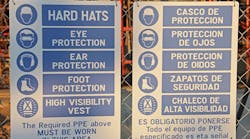Latest from Best Practices
Sponsored
By Erich Litch
Hispanic workers are key to surviving today’s labor shortage in the construction industry. They are the second-largest and fastest-growing minority group in America, making up almost a third of our labor force today. Many construction worksites, however, are English-only places of employment.
Of all US industries, construction has the most significant gap between the number of skilled workers who primarily speak a non-English language and managers who can speak those languages, according to a report from the American Council on the Teaching of Foreign Languages. In an industry that desperately needs manpower right now, more Spanish communication could open up labor markets.
According to a Dodge Data & Analytics report, about 75% of all trades use mobile device apps to capture field data these days. Technology has become the primary means of communication on worksites. To implement more Spanish communication in the technology, eSUB Construction Software and other constructech companies are adding Spanish language support to their mobile applications.
This trend is likely to continue. The US Bureau of Labor Statistics projects that from 2018 to 2028, the number of Hispanic workers in the labor force may increase by about 7.4 million—surpassing other projections based on age, sex, race, and ethnic groups. A large percentage of the increasing number of Hispanic workers will likely work in construction.
A few years ago, the number of clients requesting Spanish in our field application started increasing steadily. We partnered with native Spanish speakers from the construction industry to translate all our terms and language and incorporated those translations into our applications. The result is a business tool that has already garnered sales from clients looking for tools all their employees can easily use.
Benefits for Workers and Employers
Adding Spanish capabilities to construction apps makes it much easier for workers to input the information construction companies need to collect for projects, which can benefit both the workers and companies.
A Spanish language offering is especially relevant for construction sites in Southern and Western states, which have large Hispanic populations. Over half of the nation’s Hispanic construction workforce is concentrated in Texas (834,000), California (808,000), and Florida (317,000).
Jacob M. Monty, an immigration and employment lawyer, represents employers with large Hispanic workforces. He said the construction industry must manage the reality of work sites. “This workforce group places a high value on family and culture, and they have a strong desire for self-improvement,” Monty said. “It makes sense, then, that these three aspirations should be considered foundational points when a construction company is developing its recruitment and retention strategies.”
Monty said the emphasis on family is especially important. “One should consider ‘small talk’ an important element, as the employee of Hispanic/Latino background could feel more connected to those at work,” Monty said. “Personal contact is also very common in the Hispanic/Latino community and is considered normal. Because of the strong desire for self-improvement, Hispanic/Latino workers are very self-motivated and appreciate a workplace in which they can be promoted and advanced.”
Tom Williams, a former Construction Project Manager and Superintendent echoed that sentiment on a Quora forum. “Construction is one of the only occupations left that allows you to start from the bottom and work your way into a good, six-figure or more salary without a college degree or any form of higher education,” Williams wrote. “Construction is an excellent gateway to the “American dream” for new immigrants who are willing and able to work hard and build a life.”
Workplace Safety
Clear communication is critical for any construction site, especially in the area of safety for Hispanic workers. A Western Michigan University dissertation by Ahmed Jalil Al-Bayati revealed a higher rate of fatalities among Hispanic workers than other ethnic groups in the construction industry.
According to the dissertation, “Occupational Safety and Health Administration (OSHA) and construction safety engineers have long focused on language barriers as a root cause for these higher rates of fatality injuries and have been recommending the translation of the training materials into Spanish and promoting the hiring of bilingual supervisors.”
Having construction technology in Spanish can help Hispanic workers communicate more easily about their work and observations—making their jobs safer and more productive for them and the companies they work for. This includes more automated data collection based on biometrics, geo-location, and voice.
The choice for us in the construction industry today is simple: either meet the workforce where they are or be left behind. In the modern world, that means habla español or adiós, amigos.
Erich Litch is the Chief Executive Officer at eSUB Construction Software. He brings over 20 years of executive leadership experience from public and private software companies to the role. eSUB is the only project management and field-to-office collaboration platform designed specifically for commercial trade subcontractors. eSUB is backed by Catalyst Investors and Revolution Ventures.


